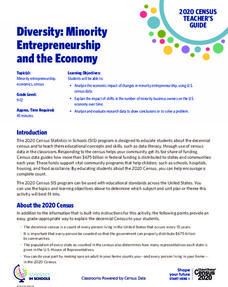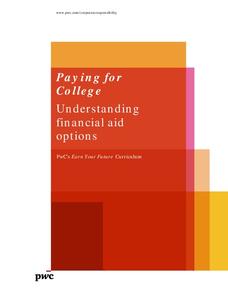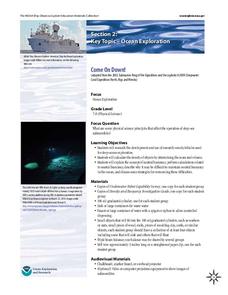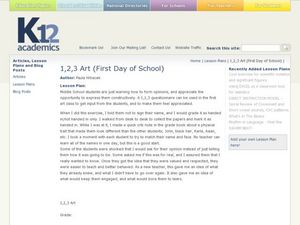US Department of Commerce
Where to Next?
Salary, education, census statistics ... how do people choose their careers? Scholars complete worksheets and rely on census data to determine their career aspirations. Then, pupils conduct Internet research about places they would...
US Department of Commerce
Diversity: Minority Entrepreneurship and the Economy
Using data from the Census Bureau, learners discover the growth in minority-owned businesses over time. After crunching numbers, analytical questions probe the reasons behind the shift.
US Department of Commerce
Featured Activity: Exploring Questions for the 2020 Census
Just what is the census for? Using data and census questions, class members explore how officials gather information. Then, they consider how the government uses the answers to determine how it spends its money with a collaborative...
Discovery Education
Sonar & Echolocation
A well-designed, comprehensive, and attractive slide show supports direct instruction on how sonar and echolocation work. Contained within the slides are links to interactive websites and instructions for using apps on a mobile device to...
PricewaterhouseCoopers
Paying for College: Understanding Financial Aid Options
With many options to pay for college, middle schoolers learn about each possibility and that continuing their education is worth the investment. They discover the difference between a grant and a loan and that some expensive colleges may...
Teaching Tolerance
Parent/Guardian Information and Preference Form
Some parent/guardian contact forms are just better than others. This one is great. Respectful, informative, complete, this communication form even includes an assurance that the information will not be shared.
NOAA
Come on Down!
What do we do when a dive is too dangerous for humans to accomplish? Send in the robots! Middle school scientists get acquainted with several different models of submersible robots in the second lesson of six from NOAA. Lab groups then...
Curated OER
How to Construct and Conduct Successful Interviews
Students conduct surveys to gain statistical information. They examine the four main types of surveys and three types of samples. Students create a practice survey, conduct field studies, and create a survey for their hometown. Students...
Curated OER
'The Flood'
Students hear the story "The Flood," and take a survey of the favorite pet animals in the class. They take the information complied in the survey and make a bar graph to show favorite pet animals using the computer program KidPix.
Curated OER
Creating Bar Graphs
Fifth graders design and label a bar graph using data taken from a class survey. They observe a teacher-led lecture, write and conduct their survey, and create a bar graph that includes identification of the minimum, maximum, mode,...
Curated OER
Community Voting Habits
Students prepare a survey about voting habits in the community. Students give the survey to parents, teachers, business owners, and other voting age members of their community, and analyze the data.
Curated OER
Opening a Restaurant
Students design a survey of the public as to what type of food should be served in restaurant that they are "planning" to open.
Curated OER
Collecting Autographs
Students investigate what a survey is and conduct one that determines what types of reading they did during the summer. They collect signatures from other students who take their survey.
Curated OER
Are We Alone
Seventh graders collect/analyze data and draw conclusions; support reasoning by using a variety of evidence; construct logical arguments; access information at remote sites using telecommunications; apply the concept of percent;...
Curated OER
One Square Meter
Learners examine various ecosystems using scientific inquiry. Using the local area, they assess the characteristics and conditions in one square meter. They report their findings in the form of a survey map and data sheet. They...
Curated OER
Health Importance
First graders create a poster about health after filling out a survey on a health topic. In this health lesson plan, 1st graders read the Staying Clean and Fit section of their health book.
Curated OER
How is our place connected to other places?
Second graders conduct a survey, they record their data with the help of maps. They use an aerial photo or Ordnance Survey map, 2nd graders pinpoint specific places and add them to a legend using the drawing tools. Students use...
Curated OER
How Many of Your Classmates...
In this surveying classmates learning exercise, students read 8 questions and survey classmates. Students ask the question, write the name of the person and their response. It is unclear what the last space is for; it could be for a...
Curated OER
Find Someone Who...
In this ESL survey worksheet, students collaborate with classmates to get to know each other by asking 7 questions. Students write down the names of classmates who answer "yes" to the questions about personal experiences and preferences.
Curated OER
Graphic Favorite Breakfast Foods
Second graders graph data based on a class survey of their favorite breakfast foods. In this graphing lesson plan, 2nd graders take a class survey of their favorite breakfast foods. Then they take that data and put it into a computer...
Curated OER
1,2,3 Art (First Day of School)
Pupils participate in a first day of school survey. For this art lesson, students answer three questions about art class, such as one thing they don't like about art class and their goals for art this coming year.
Curated OER
Favorite Fairy Tales
In this favorites survey instructional activity, students poll their classmates, teachers, parents, and friends about people's favorite fairy tales. Students complete the chart with the information.
Curated OER
House Bill No. 4097
Students identify healthy and unhealthy foods while considering a bill that would ban certain foods in schools. Through survey and discussion, they discuss a proposed legislative bill that would ban certain types of food in schools....
Curated OER
How Many of Your Classmates... (VII)
In this surveying classmates worksheet, learners poll their peers to find out the names of those who prefer any of the 8 given activities or interests. Example: "like Hello Kitty," "do karate."

























